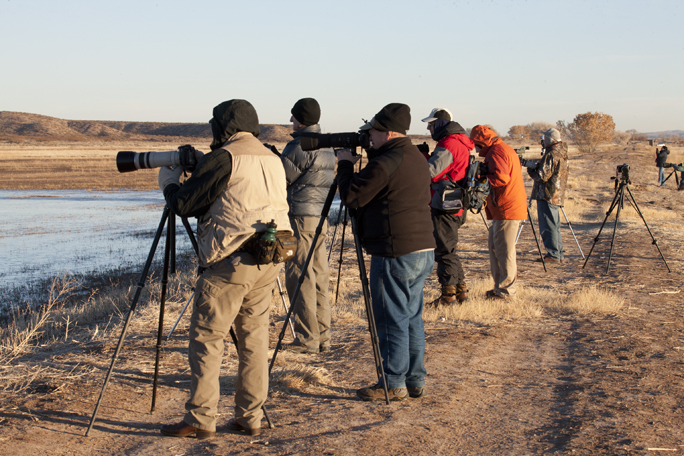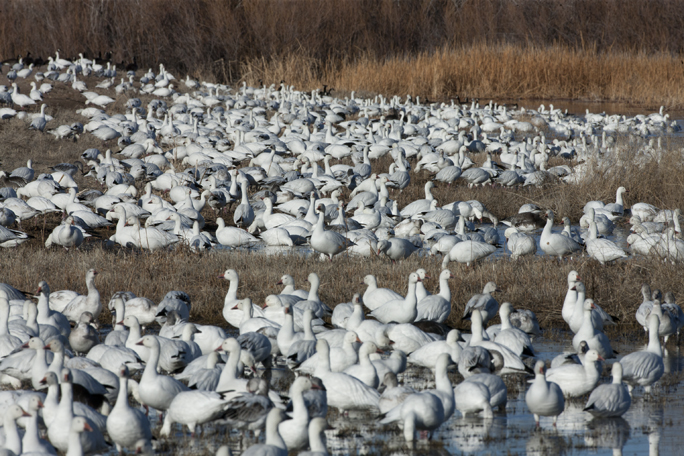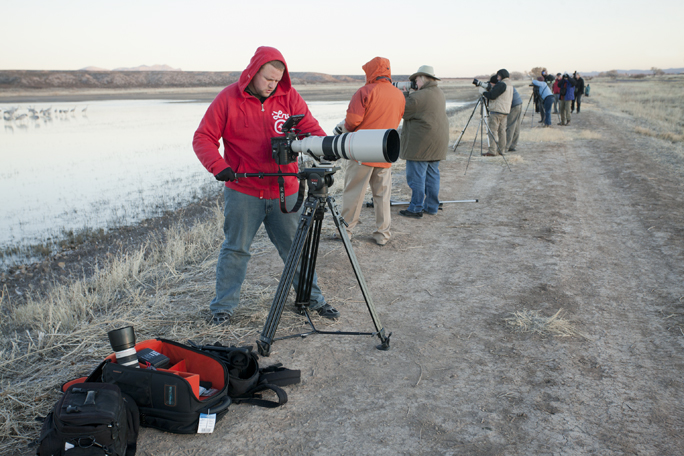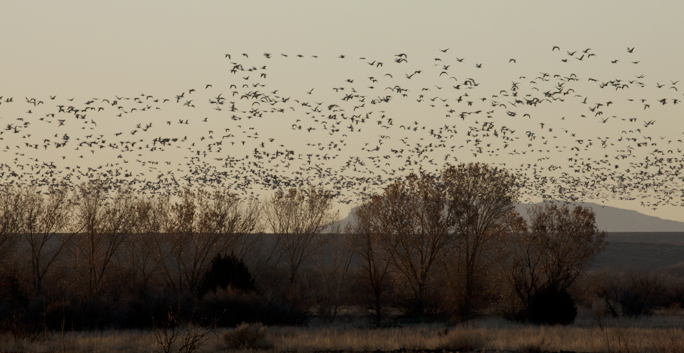Sunrise comes early at The Bosque. Though the official sunrise was 7:11 a.m. today, the birds were very active at about 6:35 a.m. The big Sand Hill Cranes had already started taking off in flights of three or four when we rolled up to the pond just north of the visitor center at Bosque del Apache, New Mexico, this morning.
Photographers line the levee adjacent to the water at the north entrance to Bosque del Apache in New Mexico. It’s worth the wait, because the birds put on such a show every day.
The photographers were also getting restless. There was a line of birdographers along the levee that lines the pond. I would guess the ratio of birds-to-photographers was about 100:1. The photographers were standing with their tripods along the water’s edge, long lenses at the ready.
This may be more than a “gaggle” of geese! Tens of thousands of Snow Geese congregate in one of the Farm fields at the Bosque. A few cranes mingle with them also.
And, it was cold. The thermometer in our rental car indicated 19 degrees when we arrived. That was two degrees colder than yesterday when I had a take a break to sit in the car due to hypothermia. I’m not used to this kind of cold, coming from San Luis Obispo where it gets down into the high 30s this time of year at the coldest.
With my layers of clothing, gloves over gloves, and wrapped in my stylish Hogwarts scarf, I was breathing frosty breaths this morning. But I felt great, and the birds were providing an amazing show.
A Sand Hill Crane taking off from the North Pond this morning at the Bosque.
My son was shooting 5K video with his Red Epic and our 600mm Canon telephoto lens. And, today I did a stint as sound man. I have an Audio Technica shotgun microphone and a small digital recorder with me, so I gathered about 20 minutes of wild bird sounds for Patrick to use under his beautiful footage.
My son Patrick shoots video of the rising sun at the Bosque. For a while he was the only photographer facing east. Eventually the others caught on.
At sunrise the light changed dramatically and we all started clicking wildly, gathering our photos of the birds as they squawked and honked and flew into the morning sky. Shutter sounds are mixed with the bird sounds on my recordings.
In the distance a virtual cloud of birds flew north from one of the fields at the Bosque. Using Photoshop’s Count feature and a grid, I was able to estimate that there are 2,500 birds in this photo. It seemed like many more when they passed us this morning.
This is our last day at the Bosque. Tomorrow morning we plan to drive west to the Very Large Array of radio-telescopes operated by the National Radio Astronomy Observatory, funded by the National Science Foundation.
These antennas are located out in the middle of nowhere between Socorro, New Mexico and the Arizona border. There are 28 of the huge dishes arranged along a three-sided set of railroad tracks. The VLA antennas are used by scientists to look out into the heavens and analyze radio emissions from the edges of the universe.
They can collect electromagnetic signals as slow as 1 Hz, and way past the human visible spectrum. They routinely find black holes, galactic anomalies, and radiation that cannot be collected with optical telescopes. From this data, the analysts put together sometimes-visible images of deep space. It’s very exciting stuff, and I am looking forward to seeing the VLA first-hand.
I’ll post photos on Monday, as Sunday I will be traveling back to California. I have an 8:00 a.m. class on Monday morning – on digital photography – so I have to be ready to go as soon as I get back.






